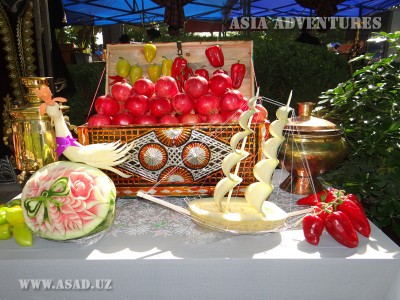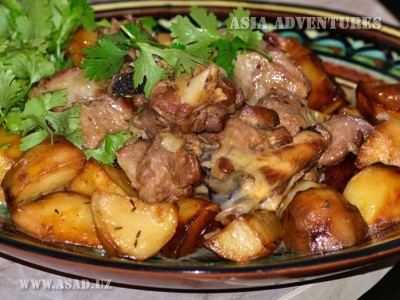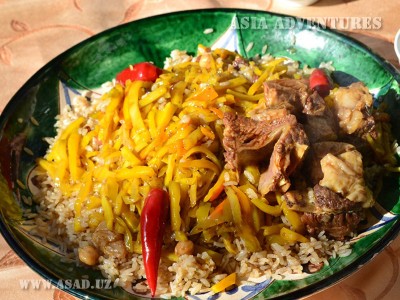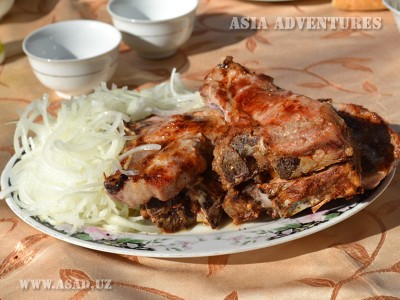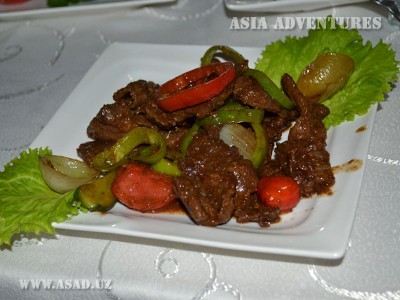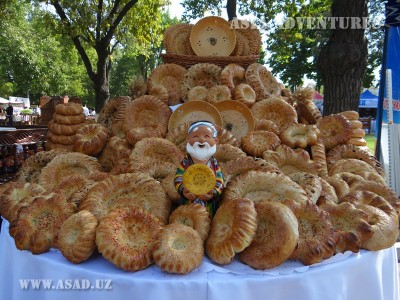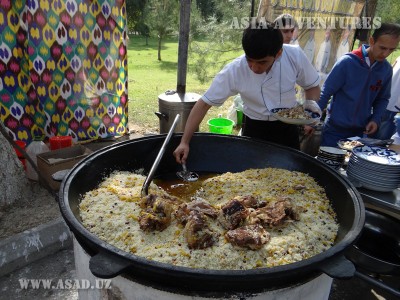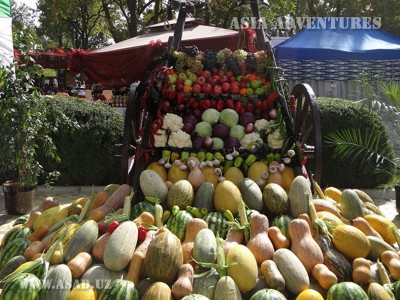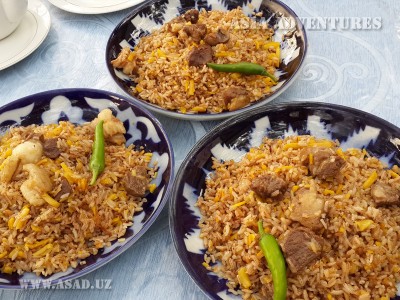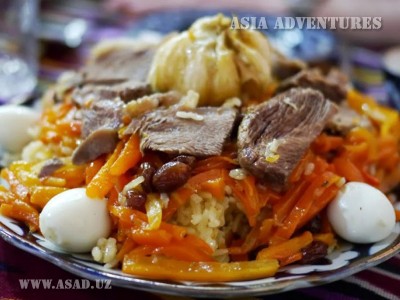
Some people may think that the only dish of the Uzbek kitchen is pilaf. However, it is far from being so.
The Uzbek national kitchen has a long history and is closely connected with the Uzbek culture, language, traditions and climatic and geographical conditions. Unlike their geographical neighbours (Kazakhs, Karakalpaks, Kyrgyz and Turkmens), who always led only a nomadic way of life, the Uzbeks in the course of their history have been both nomads and a settled nation. This, together with the adoption of the culinary traditions of the Persian and Tajik cultures, made the local kitchen highly diverse and original. Most of the Uzbek dishes, such as pilaf, lagman, manty and a lot of others, have common roots with similar dishes from the kitchens of other Asian nations. However, Uzbekistan has its own special ways of cooking these meals and its own special dishes. Although the principal dishes formed thousands of years ago, the Uzbek kitchen has in the course of its history been enriched by new ingredients and cooking methods taken from the Russian, Ukrainian, Caucasian, Tartar, Uighur and European cuisines.
The Uzbek national kitchen includes nourishing and aromatic meat dishes, thick soups with fresh vegetables and herbs, exotic sweets and original pastry. The peculiarities of the Uzbek kitchen, like those of all other national kitchens, are conditioned by the specificity of the local agriculture. Grain farming has always been a highly developed branch of agriculture in Uzbekistan, which has resulted in a wide range of dishes with noodles and breads. Sheep breeding is also one of the most advanced branches of agriculture in Uzbekistan, which is why mutton is the most popular type of meat, included in most of the dishes of the Uzbek cuisine. Horse and camel meat is also used in cooking.
The Uzbek kitchen contains a great number of recipes, with over 100 types of pilaf, 60 types of soup and 20 types of shashlik.
Pilaf is doubtless the most popular meal in Uzbekistan. It can both be eaten as an ordinary everyday meal and be served on special occasions, religious or secular. Certainly, each region boasts a special recipe. Pilafs from Fergana, Samarkand and Tashkent differ mainly in the way of cooking and in the additions to the main ingredients.
Among a variety of soups lagman and shurpa are the best known, the former consisting of noodles, meat and potatoes and the latter of mutton and vegetables.
Manty is a traditional dish consisting of large dumplings with meat, pumpkin and herbs steamed in a large pot.
Uzbek bread, which has a round form and is baked in a tandoor, a special clay oven, also varies greatly in shape and taste. Samsa is another national meal, which has the form of pasties filled with meat, onion and sheep fat and is also cooked in the tandoor.
In Uzbekistan no meal goes without sweets. They are served before the main course with green tea – the main beverage in Uzbekistan. The sweets include dried apricots, raisins, nuts, halva, parvarda, pahlava, honey and, in spring time, sumalak, the tastiest and healthiest dish of wheat with young shoots.
The basic meat dishes are usually fried in cotton oil and fat of sheep’s tail, with the addition of other sorts of oil, spices and herbs. As a rule, large quantities of onion are added to meat dishes, the proportion of onion to meat being much greater than that in European kitchens.
There are a number of meals with complex recipes requiring much manual work and, therefore, experience and skill. Pilaf with tens and even hundreds of kilogrammes of rice cooked for big events wants particular professionalism. Manty and chuchvara (meat dumplings) are made by hand, while sumalak, the popular spring-time meal, is boiled on weak fire for more than 10 hours, the preliminary stage of preparing the wheat grains taking several days and more.
Today modern gas and electric cookers and kitchen utensils are widely used for preparing national Uzbek dishes. However, traditional cooking methods are still very popular in the country. A kazan, a cast-iron semispherical cauldron, is one of the basic cooking utensils. The clay oven tandoor is also a very important cooking element for Uzbekistan, particularly in the rural area.
A lagan, a large shallow plate, is a type of traditional tableware, in which pilaf and other dishes are served. Forks are rarely used at an Uzbek meal: pilaf, for instance, is eaten with either the hand or a spoon. Other tableware includes a kosa (bowl) and piala (small bowl for tea).
The Uzbek kitchen varies considerably in different regions of Uzbekistan. Pilaf and dishes of flour are more common for the northern regions of the country, while the southern part of Uzbekistan is famous for vegetable and rice dishes with the addition of a great variety of other components. As for the pilaf, the Fergana valley is characterised by dark and strongly fried pilaf, while pilaf from Tashkent is lighter.
In Uzbek families meals are usually cooked by men. Pilaf with 100 and more kilogrammes of rice is cooked in a large cauldron exclusively by men. For a European tourist it is very hard to enjoy fully an Uzbek feast. First, the dishes of the Uzbek kitchen usually contain much fat and are very nourishing. And second, Uzbeks eat slowly, relishing every piece. A long series of dishes at an Uzbek dinner will strike the unprepared imagination of those who are accustomed to diets. Up to ten courses in one meal is a usual thing for the Uzbek hospitality.
Uzbeks usually have only three meals a day, but every meal consists of a number of dishes, each of which is highly nourishing and rich in calories. The main dishes are served for supper, first, because it is often hot during the day, and second, because many of the Uzbek dishes require much time for cooking, sometimes a whole day. And, certainly, a good feast with many people present, a real dastarkhan (Uzbek table), can be organised in the best way in the evening, when the bustle of the day is left behind.
There are dishes which are cooked only for big events and very dear guests. These are delicacies, such as kazy-karta, postdumba uramasi (a roll with the fat of sheep’s tail), tandoor-kabob (shashlik in a tandoor), norin, hasil (homemade sausage) and others.
The wide choice of soups and second courses in the Uzbek kitchen is contrasted by a rather limited variety of sweet food. A dessert usually consists of fresh fruit or juice of dry fruit with pahlava, nuts or halva. Sweet pastry is not so common in Uzbekistan as in the neighbouring countries.
Green tea is a traditional drink in Uzbekistan, as well as in a number of other Central Asian countries. For Uzbeks green tea is significant not only from the gastronomical, but also from the cultural aspect. The tea is served at every meal and is regarded as a symbol of hospitality. If a host offers tea to his guest, it means he is happy to see him at his home. Green tea is traditional throughout Uzbekistan, but in some regions, for instance, in Tashkent, black tea is no less popular.
Alcoholic drinks are not so popular in Uzbekistan as in European countries. However, wine is more common there than in most of the Muslim regions. There are about twenty wine factories in the country producing good wine from local sorts of grapevine. People also drink beer and strong alcohol, such as vodka and brandy.
Below is the list of the basic Uzbek dishes. No doubt, pilaf is the most popular and best known, its main components being meat, rice, carrot and onion. Uzbekistan boasts quite a variety of pilafs, which differ from each other in the way of cooking and are served in different situations (there is a wide range of ceremonial or holiday pilafs). Pilaf is not merely a dish; it is a real cultural symbol of the country. According to a tradition, if pilaf is cooked for guests, it must be cooked by the host himself. In many families this tradition is still alive.
Shashlik – pieces of meat (mutton, beef, pork, liver, fish or vegetables) held together by a skewer and roasted over charcoal;
Shurpa (soup with large pieces of meat, potatoes and fresh vegetables);
Lagman (a dish consisting of noodles, meat and vegetables, which may be a soup or a second course);
Mastava (vegetable soup with mutton and rice);
Domlama (meat stewed with vegetables);
Manty (large steamed dumplings with a meat filling);
Chuchvara and samsa (flaky pasties with meat or vegetables, which may be served for the main course or eaten for a snack);
Kaynatma shurva (broth), mohora (pea soup), ugra (noodles), chuchvara (dumplings with meat), manchiza (soup with dumplings);
Traditional bread, round in form and baked in a tandoor (clay oven);
Sweets (jams, nishalda, honey, parvarda, pahlava, sumalak).

 Centralasia Adventures
+998712544100
Centralasia Adventures
+998712544100




